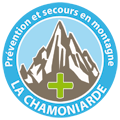Ascent the Mont Blanc is not hiking but ALPINISM !
Organize its climb, it is be able to adapt to the conditions dictated by an ascent at high altitude, an extreme sport.
The preparation physical, technical and psychological
• The technical skills must be mastered by all team members.
You will need to know include knowing how to use crampons, how to climb in varied terrain and cross ridges, and being able to adjust your rope (long on the glacier, short along the ridges, etc).
• A good and conscientious physical training (hiking, biking, running) at least 3 months before the ascent is ES-SEN-TIAL!
• Be well ACCLIMATIZE, it is carried out by some preparatory itineraries and/or progressive stay in mountains refuges (3 nights above 2500/3000 m are often needed)
• Psychologically, you must be prepared for bad nights and long days in a fabulous but hostile, different and changing environment.
Preparing your expedition means studying the terrain by reading maps, topoguides and expedition reports. A professional guide can advise, prepare and supervise you taking on responsibility for the expedition.
• As weather is changing fast and because all the tracks are not good to follow, mastering orienteering is mandatory
• Never go alone
Different routes
7 routes to the top of the Alps
There is more than one way to reach the top of Mont Blanc …
It may be more fun, particularly during the busier periods, to take one of the less traditional routes. The more technical passages demand substantial experience. Choose the route depending on the difficulty, your own abilities and conditions of the mountains.
In order of difficulty and mostly of risk exposure :
1. The normal route via Goûter
Alpine grade : PD.
It is possible, after using the Tramway du Mont Blanc from Saint Gervais (or via the Téléphérique de Bellevue from Les Houches) to overnight in Goûter refuge or from Tête Rousse refuge (3835 m – D1 : + 1450 m / D2 : + 1000 m) or at the Tête Rousse hut (3167 m – D1 : + 800 m / D2 : + 1650 m).
This second option allows to cross the infamous Goûter couloir at a good schedule and to spend a better night.
2. The Trois Monts route (Tacul, Mont Maudit, Mont Blanc)
Alpine grade : PD.
Slightly more technical than the previous itinerary, this beautiful route start from the Téléphérique de l’Aiguille du Midi and implies to overnight at the Cosmique refuge (3613 m – D1 : + 50 m / D2 : + 1250 m). The « Trois Monts » correspond to Mont Blanc du Tacul shoulder, Mont Maudit pass, and Mont Blanc.
3. The Grands Mulets route and the North East ridge of Dôme du Goûter
Alpine grade : PD.
It is the historic route of the first ascent in 1786 ! It is also the most classic route in spring for a ski ascent. Starting from the intermediate station of the Telepherique de l’Aiguille du Midi or from Plan de l’Aiguille refuge, this route goes through the Grands Mulets (3051 m – D1 : +750 m / D2 : + 1800 m).
4. Italian normal route (Pope route or Aiguilles Grises)
Alpine grade : PD.
The normal Italian route is a long and beautiful snowy itinerary on a glacier that can be complicated.
5. Traversée Miage, Bionnassay, mont Blanc
Alpine grade. : AD (fairly difficult)(exposed).
Long expedition with sharp ridge passages that are very tricky.
6. Tournette spur
Alpine grade : AD (fairly difficult).
Long, exposed expedition in wild terrain; involves committed climbing with traditional protection.
7. Innominata ridge
Alpine grade : D+.
Long, exposed expedition along a complicated route..
Equipment

• Be properly equipped for icy/snowy alpine ground and know how to use it. Shoes must be adapted to high mountain. Crampons must have “antibotts”. Bring two pairs of high mountain gloves, sunglasses made for glacier (glass of 4th categorie ), another t-shirt or layer next to the skin.
• Own a garbage bag. Mont Blanc is a very sensitive Classified Site.
• Wear a helmet, an avalanche beacon, a probe and a shovel is strongly advised. Besides avalanche, shovel can help to dig a hole in case of emergency.
• Remember that you must be prepared :
To protect yourself : Sun-cream…
To find your way : map, topo, compass, altimeter, whistle, headlamp, GPS)
To eat and drink : food rations, hot drinks.
For rescue operations: crevasse rescue kit (5 karabiners, 3 ice screws, self-locking pulley, 2 rope clamps, sling, cordelette), telephone or radio, appropriate first aid kit.


